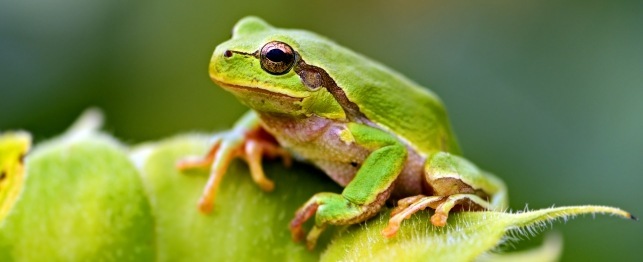

Reptiles
The green treefrog is a small common aboreal frog. It is normally beautifully colored in bright green dorsally but is capable of changing to olive-green or even brown. It is an active frog that can leap long distances, but often sits quietly for long periods – sometimes for days.
Known scientifically as Hyla cinerea, the green treefrog is one of about 625 species in the family Hylidae. At little more than two inches, the green treefrog is one of the smaller hylids.
All those available in the pet trade are collected from the wild.
Green treefrogs are found primarily in the southeastern United States. They are most normally associated with wetlands, marshes, swamps and river edge habitats, although they may wander far from their breeding ponds.
Green treefrogs are quite easy to keep as long as their terrarium is kept clean. The record reported captive lifespan for this pretty treefrog is just in excess of six years.
Green treefrogs may be green or brown (but are usually the former), and are often most easily identified by the presence of the white lateral stripes. Many also have scattered orange spots on their back. While resting, their color affords excellent camouflage.
Green treefrogs are rather slender frogs and have skin that is almost smooth. They also have a rather acutely rounded snout and prominent toepads that allow them to climb agilely. The females are slightly larger than the males.
Wild populations of green treefrogs often contain a far greater number of specimens than would be initially thought by a casual observer. You generally see only the few that are drawn to porch lights or other artificial illumination to partake of gathered insects. But a fair assessment of the number of males in a population can be had on a rainy spring night by listening to the din raised by the honking calls of a breeding colony. The females are silent.
Green treefrogs are primarily nocturnal but may be active on cloudy days during the passage of low-pressure systems. They generally do well communally. During the breeding season males may (but usually don't) grapple (wrestle) with each other to assert dominance.
The diet of the green treefrog should consist of as wide a variety of small gut-loaded insects as you can obtain. Crickets, roaches, earthworms, waxworms, trevo-worms, and mealworms will all be accepted. Additionally, non-noxious insects such as small beetles and grubs, collected from your yard (providing you don't use insecticides) are excellent treats. Dust the insects with vitamin-mineral supplements once every week or two.
Like all amphibians, treat green treefrogs as you would treat a tropical fish – as "just look, don't touch" pets. If you must handle your treefrog, wash and rinse your hands thoroughly both before and after handling. Amphibians' permeable skin will absorb any impurities from your hands, and the residue of many items that humans occasionally have on their skin – soaps, perfumes, lotions, cleaning agents, insecticides – can be injurious or fatal to your frog.
To prevent impurities from being absorbed through the skin, terrarium freshness is mandatory. The preferred temperature range is a humid 70 to 82F. These are frogs from moist habitats so as captives they require a similarly moist microhabitat.
They should be given a minimum of a 20-gallon terrarium, and a 29-gallon terrarium would probably be better for a pair or a trio. The tank should have a substrate of damp unmilled sphagnum moss (or a carpet of green woodland moss), contain vining plants (such as "pothos") for beauty, visual barriers, and to help retain a high relative humidity, and a container of fresh water.
Full-spectrum (UV producing) lighting is necessary to keep the plants alive and a glass cover over all except where the light is sitting will retain a high humidity. The tank should be gently misted once or twice a day, but don't allow a water buildup in the substrate.
Copyright © 2005-2016 Pet Information All Rights Reserved
Contact us: www162date@outlook.com